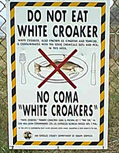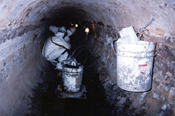Contact Superfund, Pacific Southwest
Pacific Southwest, Region 9
Serving: Arizona, California, Hawaii, Nevada, Pacific Islands, Tribal Nations
Palos Verdes Shelf

Warning signs advise people not to eat white croaker caught in the area. These fish feed on the bottom of the ocean and may contain unsafe levels of DDT and PCBs.
Timeline
OCTOBER 1989: The EPA adds the 13-acre Montrose Chemical site, located near Torrance, California, to the Superfund National Priorities List (NPL).
1990: Based on fish consumption advisories issued by the
state Office of Environmental Health Hazard Assessment (OEHHA), the state
Department of Fish and Game closes commercial fishing for white croaker
in waters near the Palos Verdes Peninsula due to health risks posed by
DDT and PCB contamination. Commercial fishing for other species continues.
Contaminated sewage from Montrose and other nearby chemical plants had
been released here until the early 1970s. OEHHA Statewide
Fish Consumption Advisories. ![]()
1990: The United States and the State of California file a lawsuit against ten facilities citing damages to the marine environment near the Palos Verdes peninsula. Damages were attributed to releases of DDT and PCBs. Four of the ten companies either owned or operated DDT-manufacturing plants in Los Angeles County. These companies were Montrose Chemical Corporation of California, Aventis CropScience USA Inc., Chris-Craft Industries Inc., and Atkemix Thirty-Seven Inc.
OCTOBER 1994: The trustee agencies release the Southern California Bight Natural Resource Damage Assessment expert reports, which provide a detailed site characterization and discuss the impacts the contaminated sediment has had on the marine ecosystem.
JULY 1996: The EPA begins an investigation of cleanup options
for the DDT- and PCB-contaminated sediments on the ocean floor off the
Palos Verdes Peninsula.
News Release

Cleaning out DDT-contaminated sediment in a sewer that received wastewater discharged from the Montrose Chemical Corporation.
MARCH 2000: The EPA completes Engineering Evaluation/Cost Analysis
(EE/CA) report for the Palos Verdes Shelf, summarizing site risks and
potential cleanup plans. The EPA proposes an interim plan to reduce human
health risks via public outreach, enforcement, and monitoring. At the
same time, EPA announces it will begin a pilot capping project in a small
portion of the site. The project would evaluate cap placement methods
and short-term impacts of cap construction.
News
Release
Pilot Project
AUGUST 2000: Pilot Capping Project begins placing clean sediment in a small area of the site northwest of the outfall pipes.
DECEMBER 2000: U.S. Department of Justice and the California Attorney General announce a settlement with Montrose Chemical Corporation of California, Aventis CropScience USA Inc., Chris-Craft Industries Inc., and Atkemix Thirty-Seven Inc.. The settlement of $73 million, when combined with prior settlements in this case, will provide a total of approximately $140 million that will help fund cleanup of DDT contamination and restoration of the Palos Verdes Shelf marine environment.
SEPTEMBER 2001: EPA issues an Action Memorandum to address existing health risks associated with consumption of contaminated fish from the Palos Verdes Shelf.
- News Release (October 2, 2001)
- Action Memoramdum for Institutional Controls (PDF) (33 pp, 79K)
- Response Summary (PDF) (37 pp, 100K)
Over the next ten years, EPA will undertake the following actions in cooperation with state and local agencies and community-based organizations:
- Public Outreach and Education - to increase awareness and understanding of the existing advisories on consumption of fish caught in this area and related fishing restrictions;
- Monitoring contaminants levels in fish - to evaluate and track contaminant concentrations in fish (primarily white croaker) caught at or near the Palos Verdes Shelf, fish sold in retail fish markets and fish served in restaurants; and
- Enforcement - to promote compliance with the commercial fishing ban and recreational catch limit for white croaker off the Palos Verdes peninsula.
October 2002: EPA, jointly with the Montrose Settlements Restoration Program, initiated fish in ocean monitoring program. 23 most commonly caught species were collected at designated locations from Ventura to Dana Point, mostly in the Los Angeles area. Fact sheet: Survey of Contaminants in Fish in Southern California (PDF) (5 pp, 166K).
January 2003: EPA initiated full scale implementation of Public Outreach and Education program. ![]()
Summer 2004: EPA initiates marketplace fish monitoring program to assess whether contaminated white croakers are reaching consumers.
May 2005: Fact sheet: EPA Site update on remedial investigations and institutional cotrols program (PDF) (6 pp, 408K)
